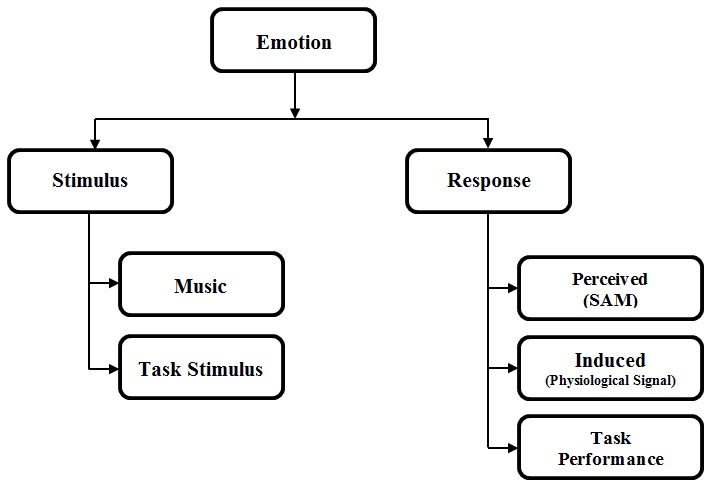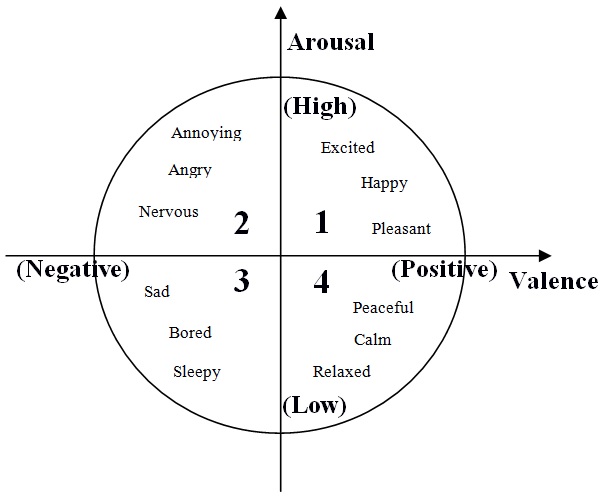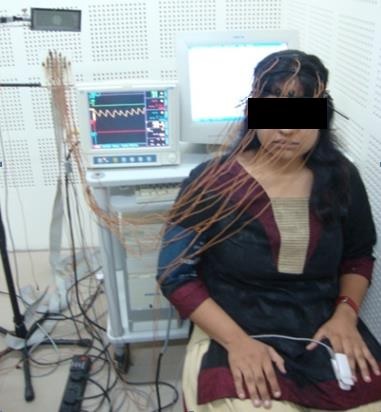Introduction
Listening to music has significant effects on emotion, perception and behaviour. An emotion is a complex and subjective phenomenon, the conscious occurrence of which is illustrated mainly through psychophysiological expressions and biological reactions that can influence the cognitive performance. It has three distinct components: a subjective experience, a physiological response and a behavioural response. The way each individual responds to the given stimulus is inconstant. Therefore, selecting a stimulus becomes an important criterion to induce emotion [1]. Many methods have been employed to induce emotion in the laboratory settings. There are number of sets of stimulus available to evoke emotion like Ekman and Friesen set [2], the Japanese and Caucasian Facial Expression of Emotion set (JACFEE) and the Montreal Set of Facial Displays for Emotion (MSFDE) [3,4]. De Silva LC et al., used faces as emotion stimulus since they are best reflector for emotion perception [5]. Apart from that, emotional speeches are used as a stimulus and the induced emotion is measured using facial expressions. However, some individuals tend to smile during negative emotional experiences. In such cases, this approach may not actually reflect a person’s true emotional state [6]. The methodology of emotion induction and measurement is shown in [Table/Fig-1].
Methodology of emotion induction and measurement.

An International Affective Picture System (IAPS) database was developed that contains varying degrees of emotional states static images as photographs [7]. However, since they are static, they may not illustrate all aspects of affective space when the static images are presented. International Affective Digital Sounds (IADS) is later considered as a better stimulus in analysing the emotion perception. Schaefer A et al., used films as stimulus set (visual and auditory stimuli), as they have a moderately elevated degree of natural strength to evoke emotion [8]. However, participant familiarity can introduce variability and individual differences which are important aspects of the emotional responses to films.
Human Emotion
The human emotion is defined in two-dimensional emotional spaces as valence–arousal emotion model [Table/Fig-2] and it is reported that even at present, the valence–arousal emotion model is a highly reliable model in assessing induced emotion [9,10]. The horizontal dimension symbolises valence from unpleasant to pleasant and vertical dimension stands for arousal from low activation to high activation. This common model has been studied widely to assess valence and arousal in two-dimensional anatomical space [10]. In another study, a set of emotion words were utilised repeatedly i.e., valence and arousal [11]. The valence words were used for analysing critical paradigms which exhibit a negative word (i.e., “murder”). This negative word would not have an impact when the participants were accustomed to tuning in to those words much of the time. The feared objects/events are the real stimuli like spiders/snakes, mountaineering and sky diving [12], disgust or pleasure induced by food or other substances [13], nociceptive stimuli, and chemosensory (odour) stimuli [14].
Two dimensional Russell Circumflex Model [9].

Blood and Zatore investigated subject selected music in their research to produce a more reliable and intense emotional response [15]. Music has been shown to alter or evoke emotions with subjectively pleasant music leading to positive emotions while unpleasant leading to negative ones, these induced emotions reflect changes in the physiological responses. Listening to music of different culture had an effect on American participants, but they rated the Indian music as tenser while listening. On the other hand, Indian participants assessed western music as tenser [16]. Listeners can perceive emotions on various factors like popularity of the music, genre, traditional culture, etc. Sometimes, they report pleasure in reaction to sad sounding music, in this scenario the perceived and induced emotions differ substantially [17].
Methods of Evaluating Emotion Induction
The ability of music to induce emotion has been studied by numerous researchers as it has the potential to enhance or weaken the listener’s emotion [1,17,18]. Music can also be used to enhance the emotional experience [1]. The content of music (lyrics) is also important to induce emotion and is extremely subjective. Music helps in refreshing one’s memory and thereby enhancing the cognitive function [18]. Evidence suggests that the body and mind can be altered with the aid of music, and studies have shown that both the psychological and physiological health of an individual improves following music therapy [19]. In addition, music may modify behaviour in autistic children and improve motor skills among Parkinson’s disease patients [20,21]. Furthermore, in endocrine system, music has an optimistic effect and can facilitate concentration and enhances information processing. The higher cognitive factors are recovered by music which involves complex sounds and speech [22].
Interestingly, the most recent advances in music, psychoanalysis in neurologic music therapy, driven by learning and training paradigms, have shown lasting effects on changes in neural plasticity and behavioural function in therapy and rehabilitation [23]. Music possesses the ability to act as a tool to alleviate stress and improve efficiency of learning. Incredibly, though it is a widespread activity, music listening varies across culture. Listening to the right type of music is one of the factors in causing positive effects on the body and improves attention. These effects have strong association with the work flow of the neurological system (brain and nerve) in the human body. Moreover, music-listening habits enhance the activation of neurons and synapses [24].
Music Processing in the Brain
Thalamus in the limbic system of the brain is associated with changes in emotional reactivity. When the physical symptoms of emotion appear, the threat they pose return via the hypothalamus, to the limbic centers and hence, increases anxiety. This negative feedback mechanism can be strong enough to generate a situation of panic. Amygdala is the part of the limbic structure which is involved in emotional and attention processes. An associative process takes place in the amygdala, which then ventures to hypothalamic and brain stem targets in order to facilitate the various symptoms of fear [25].
While listening to music various structures in the brain are activated this include the auditory cortex, frontal cortex, cerebral cortex and even the motor cortex [26]. Basic musical features like pitch and loudness are processed in the primary auditory cortex, secondary auditory cortex focusses on harmonic, melodic and rhythmic patterns and the tertiary auditory cortex integrates these patterns into an overall perception of music [27]. Apart from auditory cortex, sensory motor cortex also plays a role while listening to music wherein the left and right primary sensor motor areas are involved in the preparation, execution and termination of the musical sequence [26].
There is an increased activation of the brain over a period of minutes during the course of listening to music (temporal dynamics) in all the structures (amygdala, parahippocampal gyrus, temporal poles, Inferior Frontal Gyrus (IFG), inferior (Brodmann’s area) (BA 44, BA 45, and BA 46), anterior superior insula, ventral striatum, Heschl’s gyrus, and Rolandic operculum) [28]. Melody and rhythm are processed differently by the brain; melody processing includes activity of two areas of Superior Temporal Gyrus (STG) and Planum Polar (PP) [29].
Electroencephalogram/functional magnetic resonance imaging (EEG/fMRI) and Electroencephalogram/Positron Emission Tomography (EEG/PET) are used to study the neurodynamics of the brain (temporal and spatial resolution). Functional Magnetic Resonance Imaging (MRI) study reports that when pleasant music is presented to the subject, there is an increase in Blood Oxygen Level Dependent (BOLD) in ventral striatum and anterior insula whereas unpleasant or dissonant music increase BOLD in the amygdala, the hippocampus and parahippocampal gyrus [29]. It is found that the brain structures respond differently to pleasant and unpleasant stimuli. Changes are observed in the amygdala for both positive and negative stimuli using brain imaging studies. The PET is used to study the emotional responses to pleasant and unpleasant music and the cerebral blood flow changes are reflected in different parts of the brain when dissonance or consonance of the music is played [15]. When pleasant/unpleasant music is played, the changes are reflected in sub-callosal cingulated region of brain, the activity decreases when listening to unpleasant (increasing dissonance) music and increases when listening to pleasant (increasing consonance) music [30]. Decrease in cerebral blood flow is noted in the right orbitofrontal cortex and in sub-callosal cingulate and cerebral blood flow increase in parahippocampal gyrus is associated with unpleasant emotion evoked by disturbing pictures.
Apart from imaging studies, EEG is also used to study the brain activation of the harmonic structure of regular and irregular chords of music [Table/Fig-3]. The processing of regular chords evoke stronger increase in phase-locked and non-phase locked oscillatory activity in delta and theta frequency bands, than processing irregular chords. Different scales of cortical integration, ranging from local delta, theta and gamma oscillations, to long-range alpha phase synchronisation, which were proved to mediate the music syntax processing, bestow to the ‘unified cognitive moment’ [31].
Experimental setup of data acquisition system for recording electroencephalogram (EEG) signals.

Effect of Music on the Autonomic Nervous System Activity
The induced emotion can also be determined by evaluating the ANS activity as these changes will stimulate the periphery organs and can be evaluated by measuring Heart Rate (HR), Blood Pressure (BP), Cardiac Output (CO), Total Peripheral Resistance (TPR), Stroke Volume (SV), Respiratory Sinus Arrhythmia (RSA, also known as high frequency heart period variability), Respiratory Rate (RR), Electrodermal Activity (EDA; including event-related skin conductance responses), Tidal Volume (TV), the Electrogastrogram (EGG), pupillary diameter, face or hand temperature. These measures distinguish positive from negative affective states [32]. When exposed to music activity, changes have been reported in the anterior cingulate cortex and insular cortex; these are associated with changes in autonomic activity [33]. When the sympathetic system is stimulated, the HR and BP get increased, whereas, parasympathetic system reduces the HR and BP.
The fast tempo music increases the blood pressure and HR while the slow tempo music has opposite effects on the body [34]. Rock music is found to increase the HR when compared to classical music and no music condition and higher systolic BP is reported while listening to classical music than rock. An increase in HR, respiratory frequency and BP is noted with an increase in tempo of playing music when compared to silence and all these parameters gets decreased to below baseline levels. There is always an individual variation to the appreciation of any music [35].
Music can induce positive or negative emotion. Positive emotions are associated with coherent patterns of heart rhythms thereby increasing the parasympathetic activity which can enhance the person’s ability to function [36]. Negative emotions such as anger and anxiety can have adverse effect on the person’s ability to concentrate, learn and reason [36]. Stronger emotion induces sympathetic activation and the HR was observed to be higher for expressive performance task. Physiological changes (BP, HR and other cardiovascular variables) during listening to music become an objective index of autonomic correlates of brain activation.
Conclusion
Listening to music based on individual culture and preferences enhance the perceived and induced emotion responses. It is clear that concentration and information processing is also affected positively by music, thus enhancing learning by helping intake information and augmenting cognitive skills. This review concludes that associating neurosciences and musicology will provide a modern modality and also create a platform for the development of music-based exercise models to induce changes in the emotion.
[1]. Panksepp J, Bernatzky G, Emotional sounds and the brain: The neuro-affective foundations of musical appreciation Behav Processes 2002 60(2):133-55.10.1016/S0376-6357(02)00080-3 [Google Scholar] [CrossRef]
[2]. Ekman P, Friesen WV, Pictures of facial affect 1976 Palo Alto, CAConsulting Psychologists Press [Google Scholar]
[3]. Matsumoto D, Ekman P. Japanese and caucasian facial expressions of emotion and neutral faces (JACFEE and JACNeuF), 1988. Available from http://www.paulekman.com [Google Scholar]
[4]. Beaupré MG, Cheung N, Hess U. The montreal set of facial displays of emotion [Slides], 2000. (Available from Ursula Hess, Department of Psychology, University of Quebec at Montreal, Montreal, Quebec, Canada). (Database: http://www.psychophysiolab.com/en/download.php) [Google Scholar]
[5]. De Silva LC, Miyasato T, Nakatsu R, Facial emotion recognition using multi-modal information In Proc. IEEE International Conference on Information, Communications and Signal Processing (ICICS) 1997 :397-401. [Google Scholar]
[6]. Kim J, Andre E, Emotion recognition based on physiological changes in music listening IEEE Trans Pattern Anal Mach Intell 2008 30(12):2067-82.10.1109/TPAMI.2008.2618988943 [Google Scholar] [CrossRef] [PubMed]
[7]. Bradley MM, Lang PJ, Measuring emotion: Behavior, feeling, and physiology. In Lane RD, Nadel L. Series in Affective Science Cognitive Neuroscience of Emotion 2000 New YorkOxford University Press:242-76. [Google Scholar]
[8]. Schaefer A, Nils F, Sanchez X, Philippot P, Assessing the effectiveness of a large database of emotion-eliciting films: A new tool for emotion researchers Cognition and Emotion 2010 24(7):1153-72.10.1080/02699930903274322 [Google Scholar] [CrossRef]
[9]. Russell JA, A circumplex model of affect Journal of Personality and Social Psychology 1980 39(6):1161-78.10.1037/h0077714 [Google Scholar] [CrossRef]
[10]. Thammasan N, Fukui KI, Moriyama K, Numao M, EEG based emotion recognition during music listening In Proc. 28th Annual Conference of the Japanese Society for Artificial Intelligence 2014 :12-15. [Google Scholar]
[11]. Bradley MM, Lang PJ, Affective norms for English words (ANEW): Instruction manual and affective ratings, Technical Report C-1, Center for Research in Psychophysiology 1999 University of Florida:1-45. [Google Scholar]
[12]. Castanier C, LeScanff C, Woodman T, Mountaineering as affect regulation: The moderating role of self-regulation strategies Anxiety Stress Coping 2011 24(1):75-89.10.1080/1061580100377421020397078 [Google Scholar] [CrossRef] [PubMed]
[13]. Jabbi M, Swart M, Keysers C, Empathy for positive and negative emotions in the gustatory cortex NeuroImage 2007 34(4):1744-53.10.1016/j.neuroimage.2006.10.03217175173 [Google Scholar] [CrossRef] [PubMed]
[14]. Yeshurun Y, Sobel N, An odor is not worth a thousand words: From multidimensional odors to unidimensional odor objects Ann Rev Psychol 2010 61:219-41.10.1146/annurev.psych.60.110707.16363919958179 [Google Scholar] [CrossRef] [PubMed]
[15]. Blood AJ, Zatorre RJ, Intensely pleasurable responses to music correlate with activity in brain regions implicated in reward and emotion Proc Nati Acad Sci USA 2001 98(20):11818-23.10.1073/pnas.19135589811573015 [Google Scholar] [CrossRef] [PubMed]
[16]. Wong PC, Roy AK, Margulis EH, Bimusicalism: The implicit dual enculturation of cognitive and affective systems Music Percept 2009 27(2):81-88.10.1525/mp.2009.27.2.8120657798 [Google Scholar] [CrossRef] [PubMed]
[17]. Garrido S, Schubert E, Individual differences in the enjoyment of negative emotion in music: A literature review and experiment Music Percept 2011 28:279-95.10.1525/mp.2011.28.3.279 [Google Scholar] [CrossRef]
[18]. Thaut MH, McIntosh GC, Neurologic music therapy in stroke rehabilitation Current Physical Medicine and Rehabilitation Reports 2014 2(2):106-13.10.1007/s40141-014-0049-y [Google Scholar] [CrossRef]
[19]. Cooke ML, Moyle W, Shum DH, Harrison SD, Murfield JE, A randomized controlled trial exploring the effect of music on agitated behaviours and anxiety in older people with dementia Aging Ment Health 2010 14(8):905-16.10.1080/1360786100371319020635236 [Google Scholar] [CrossRef] [PubMed]
[20]. Trappe JH, Music and medicine: The effects of music on the human being Appl. Cardiopulm. Pathophysiol 2012 16:133-42. [Google Scholar]
[21]. Pacchetti C, Mancini F, Aglieri R, Fundarò C, Martignoni E, Nappi G, Active music therapy in Parkinson’s disease: an integrative method for motor and emotional rehabilitation Psychosom Med 2000 62(3):386-93.10.1097/00006842-200005000-0001210845352 [Google Scholar] [CrossRef] [PubMed]
[22]. Särkämö T, Pihko E, Laitinen S, Forsblom A, Soinila S, Mikkonen M, Music and speech listening enhance the recovery of early sensory processing after stroke J Cogn Neurosci 2010 22(12):2716-27.10.1162/jocn.2009.2137619925203 [Google Scholar] [CrossRef] [PubMed]
[23]. Hömberg V, Neurorehabilitation approaches to facilitate motor recovery Handbook of Clinical Neurology 2013 110:161-73.10.1016/B978-0-444-52901-5.00014-923312639 [Google Scholar] [CrossRef] [PubMed]
[24]. Bennet A, Bennet D, The human knowledge system: Music and brain coherence VINE 2008 38:277-95.10.1108/03055720810904817 [Google Scholar] [CrossRef]
[25]. Rajmohan V, Mohandas E, The limbic system Indian J Psychiatry 2007 49(2):132-39.10.4103/0019-5545.3326420711399 [Google Scholar] [CrossRef] [PubMed]
[26]. Kristeva R, Chakarov V, Schulte-Mönting J, Spreer J, Activation of cortical areas in music execution and imagining: a high-resolution EEG study NeuroImage 2003 20(3):1872-83.10.1016/S1053-8119(03)00422-1 [Google Scholar] [CrossRef]
[27]. Abbott A, Music, maestro, please! Nature 2002 416(6876):12-14.10.1038/416012a11882864 [Google Scholar] [CrossRef] [PubMed]
[28]. Pizzagalli DA, Oakes TR, Davidson RJ, Coupling of theta activity and glucose metabolism in the human rostral anterior cingulated cortex: an EEG/PET study of normal and depressed subjects Psychophysiology 2003 40(6):939-49.10.1111/1469-8986.0011214986847 [Google Scholar] [CrossRef] [PubMed]
[29]. Pouladi F, Oghabian MA, Hatami J, Zadehmohammadi A, Involved brain areas in processing of Persian classical music: an fMRI study Procedia-Social and Behavioral Sciences 2010 5:1124-28.10.1016/j.sbspro.2010.07.247 [Google Scholar] [CrossRef]
[30]. Flores-Gutiérrez EO, Dìaz JL, Barrios FA, Favila-Humara R, Guevara MA, Del Rìo-Portilla Y, Metabolic and electric brain patterns during pleasant and unpleasant emotions induced by music masterpieces Int J Psychophysiol 2007 65(1):69-84.10.1016/j.ijpsycho.2007.03.00417466401 [Google Scholar] [CrossRef] [PubMed]
[31]. Varela F, Lachaux JP, Rodriguez E, Martinerie J, The brainweb: phase synchronization and large-scale integration Nat Rev Neurosci 2001 2(4):229-39.10.1038/3506755011283746 [Google Scholar] [CrossRef] [PubMed]
[32]. Crawford JR, Henry JD, The Positive and Negative Affect Schedule (PANAS): Construct validity, measurement properties and normative data in a large non-clinical sample Br J Clin Psychol 2004 43(pt3):245-65.10.1348/014466503175293415333231 [Google Scholar] [CrossRef] [PubMed]
[33]. Critchley HD, Elliott R, Mathias CJ, Dolan RJ, Neural activity relating to generation and representation of galvanic skin conductance responses: a functional magnetic resonance imaging study J Neurosci 2000 20(8):3033-40.10.1523/JNEUROSCI.20-08-03033.200010751455 [Google Scholar] [CrossRef] [PubMed]
[34]. Edworthy J, Waring H, The effects of music tempo and loudness level on treadmill exercise Ergonomics 2006 49(15):1597-610.10.1080/0014013060089910417090506 [Google Scholar] [CrossRef] [PubMed]
[35]. Bernardi L, Porta C, Sleight P, Cardiovascular, cerebrovascular, and respiratory changes induced by different types of music in musicians and non-musicians: the importance of silence Heart 2006 92(4):445-52.10.1136/hrt.2005.06460016199412 [Google Scholar] [CrossRef] [PubMed]
[36]. McCraty R, Atkinson M, Rein G, Watkins AD, Music enhances the effect of positive emotional states on salivaryiga Stress Medicine 1996 12(3):167-75.10.1002/(SICI)1099-1700(199607)12:3<167::AID-SMI697>3.0.CO;2-2 [Google Scholar] [CrossRef]